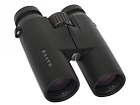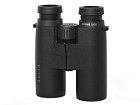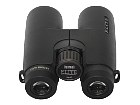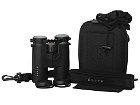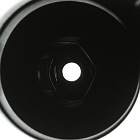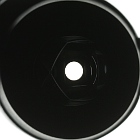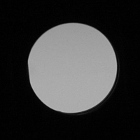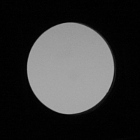Bushnell Elite 8x42 ED
The Elite series binoculars are Schmidt-Pechan roof prism devices. Their prisms, made of BaK-4 glass, are phase-coated and they feature one dielectric surface which is supposed to ensure the highest amount of reflected light.
All air-to-glass surfaces of the tested binoculars are covered by XTR multilayer coatings (in fact the producer boasts of as many as 60 layers of those) so the transmission amounts to 99.73% on one air-to-glass surface. What’s more, the outer elements are covered by hydrophobic RainGuard® HD layers which task is to prevent the dirt from sticking to optical elements. The casing of the lens is made of magnesium alloys and covered by high quality rubber. It is also nitrogen-filled, rain- and splash-proof and its body is submersible to a certain degree. Buyers get a hard case, a strap and caps for objectives and eyepieces in the product bundle.
| Magnification | Lens diameter | Angular field of view | Prisms | Eye relief | Weight | Price |
|---|---|---|---|---|---|---|
| 8 | 42 | 110/1000(6.3o) | BaK-4/roof | 19.5 mm | 728 g | 2449 PLN |
Summary
Pros:
- compact but solid casing,
- good transmission,
- well-corrected chromatic aberration,
- slight astigmatism,
- negligible coma,
- moderate distortion,
- unnoticeable brightness loss on the edge of the field of vision,
- dark area around exit pupils,
- correct whiteness rendering,
- good quality of coatings and prisms, made of BaK-4 glass,
- good warranty conditions.
Cons:
- narrow field of view,
- truncated exit pupils.
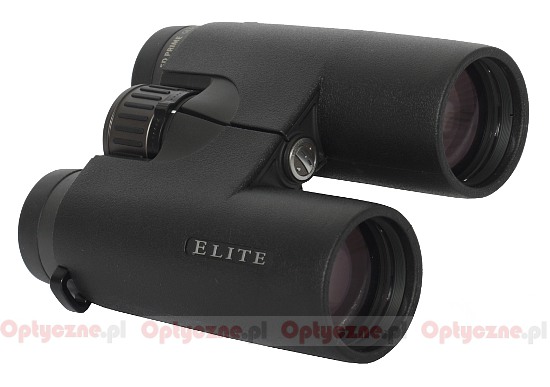 |
When it comes to the field of view and the price of the tested Bushnell Elite 8x42 ED, it is directly comparable to such pairs of binoculars as the Kowa 8x42 BD42-8, the Pentax DCF 8x43 ED or the Docter 8x42 ED. In the following chart you can find a comparison of the parameters of those instruments.
The shortest summary of our test could be like this: the Bushnell, being noticeably better, is only a bit more expensive than the Kowa. What’s more, it is significantly cheaper than the Pentax and the Docter and just a tad worse than those two. It seems it fits very well the medium and top price shelf of 8x42 class of binoculars. You must pay for it a bit more than for the Kowa but you are sure the optical properties will be better. If you cannot afford the most expensive Docter and the Pentax, the Bushnell is really an interesting option. All of it is true providing that two basic flaws of the tested binoculars don’t worry you.
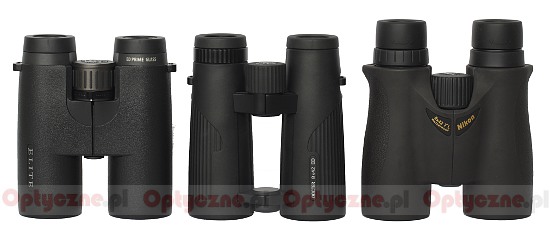 Bushnell Elite 8x42 ED, Docter 8x42 ED and Nikon HG 8x42. |
The first of them is the field of view which amounts to 6.3 degrees – in an instrument with the magnification ratio of 8 it doesn’t impress at all. However, if a producer decides to use such a field it should be corrected in a perfect way. Bushnell constructors didn’t manage to do that - for example the degree of distortion correction or the field curvature should be considered as just moderate. The second problem – truncated exit pupils – means that several percent of light, so diligently gathered, simply don’t reach your eyes. Pity, because those several percent are exactly the reason why different producers employ better and better anti-reflective coatings; by the way in the case of the tested Bushnell the coatings work perfectly well, providing quite sensible transmission and colour rendering.
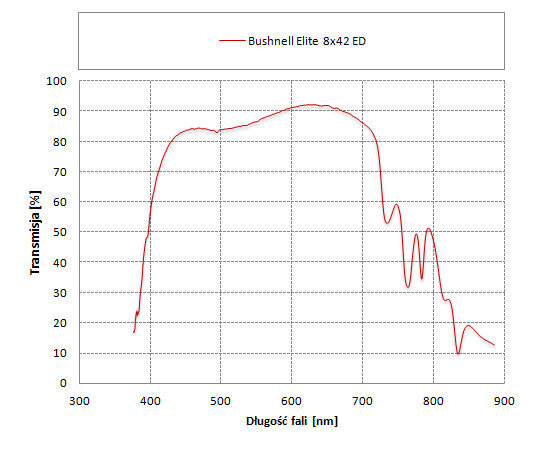 |
In our 8x42 binoculars ranking there was a small gap between 125 and 131.6 points. The Bushnell Elite 8x42 ED filled it very nicely - compared to more expensive and only slightly better instruments it is a good price/quality compromise; it can be also an interesting option if you want to save money providing you don’t care about a narrower field of view and you want to have a high quality pair of binoculars produced in Japan.





